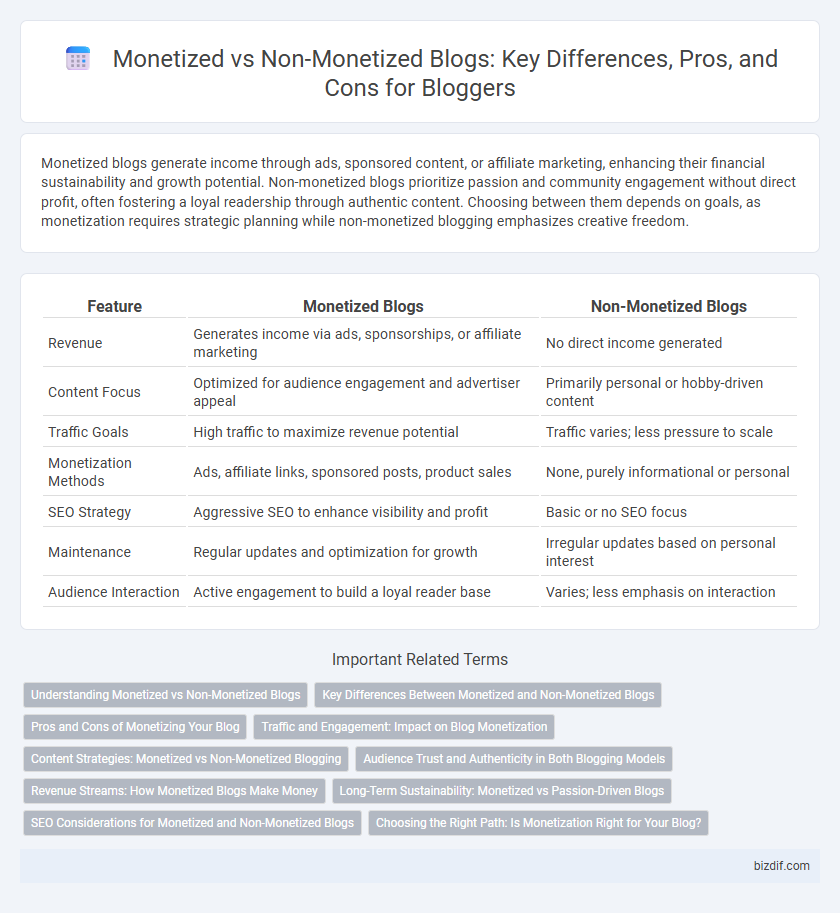Monetized blogs generate income through ads, sponsored content, or affiliate marketing, enhancing their financial sustainability and growth potential. Non-monetized blogs prioritize passion and community engagement without direct profit, often fostering a loyal readership through authentic content. Choosing between them depends on goals, as monetization requires strategic planning while non-monetized blogging emphasizes creative freedom.
Table of Comparison
| Feature | Monetized Blogs | Non-Monetized Blogs |
|---|---|---|
| Revenue | Generates income via ads, sponsorships, or affiliate marketing | No direct income generated |
| Content Focus | Optimized for audience engagement and advertiser appeal | Primarily personal or hobby-driven content |
| Traffic Goals | High traffic to maximize revenue potential | Traffic varies; less pressure to scale |
| Monetization Methods | Ads, affiliate links, sponsored posts, product sales | None, purely informational or personal |
| SEO Strategy | Aggressive SEO to enhance visibility and profit | Basic or no SEO focus |
| Maintenance | Regular updates and optimization for growth | Irregular updates based on personal interest |
| Audience Interaction | Active engagement to build a loyal reader base | Varies; less emphasis on interaction |
Understanding Monetized vs Non-Monetized Blogs
Monetized blogs generate revenue through methods such as affiliate marketing, sponsored content, and ad placements, emphasizing content that attracts high traffic and engagement. Non-monetized blogs typically prioritize sharing knowledge or personal experiences without direct financial incentives, often fostering a more authentic connection with readers. Understanding the difference helps bloggers align their content strategy with goals, whether for income generation or community building.
Key Differences Between Monetized and Non-Monetized Blogs
Monetized blogs generate revenue through methods such as affiliate marketing, sponsored content, and ad placements, whereas non-monetized blogs primarily focus on content sharing without direct financial gains. Monetized blogs require strategic audience targeting, SEO optimization, and consistent content updates to maximize income, while non-monetized blogs prioritize personal expression or community engagement without prioritizing traffic metrics. The key difference lies in the purpose and approach: monetized blogs operate as business entities aiming for profitability, while non-monetized blogs function mainly as platforms for passion projects or informational sharing.
Pros and Cons of Monetizing Your Blog
Monetized blogs generate income through ads, affiliate marketing, or sponsored content, providing financial incentives that can support consistent content creation and growth. However, monetization can lead to decreased reader trust if ads are intrusive or content shifts to prioritize profit over value. Non-monetized blogs often maintain a more authentic connection with readers but may struggle with sustainability and scaling opportunities.
Traffic and Engagement: Impact on Blog Monetization
Monetized blogs often experience higher traffic and engagement due to targeted content strategies, SEO optimization, and promotional efforts that attract advertising partners and affiliate marketing opportunities. Non-monetized blogs may prioritize authentic audience connection and community building, resulting in consistent, organic readership but slower growth in traffic volume. The impact on blog monetization is significant as higher traffic and active engagement directly correlate with increased revenue potential through ads, sponsored content, and product sales.
Content Strategies: Monetized vs Non-Monetized Blogging
Monetized blogs prioritize content strategies that boost traffic and audience engagement through SEO optimization, affiliate marketing, and sponsored posts to generate revenue. Non-monetized blogs often focus on niche expertise, storytelling, or community-building with more freedom to explore varied topics without the pressure of profitability. Both approaches require consistent, high-quality content, but monetized blogs integrate strategic keywords and calls to action to maximize monetization opportunities.
Audience Trust and Authenticity in Both Blogging Models
Monetized blogs often balance between audience trust and revenue generation by integrating sponsored content and advertisements subtly to maintain authenticity. Non-monetized blogs typically foster higher perceived authenticity as they focus purely on sharing genuine experiences without commercial influence. Both models require transparency and consistent value delivery to build and sustain audience trust effectively.
Revenue Streams: How Monetized Blogs Make Money
Monetized blogs generate income through diverse revenue streams such as affiliate marketing, sponsored content, and display advertising using platforms like Google AdSense. They also capitalize on selling digital products, online courses, and premium subscriptions to create multiple income channels. In contrast, non-monetized blogs typically rely on organic traffic and audience engagement without directly earning revenue.
Long-Term Sustainability: Monetized vs Passion-Driven Blogs
Monetized blogs generate steady income through advertisements, affiliate marketing, and sponsored content, enhancing long-term sustainability by providing financial incentives to consistently produce quality content. Passion-driven blogs, while rich in authentic voice and community engagement, may struggle to maintain regular updates without monetary rewards, risking diminished audience interest over time. Balancing passion with monetization strategies often leads to improved longevity by fueling both creative motivation and financial viability.
SEO Considerations for Monetized and Non-Monetized Blogs
Monetized blogs prioritize SEO strategies that enhance ad visibility, keyword targeting for high CPC terms, and user engagement metrics to maximize revenue; conversely, non-monetized blogs focus primarily on organic traffic, content relevance, and backlink quality to build authority and audience trust. SEO for monetized blogs often includes optimizing for paid search intent and integrating affiliate marketing links, whereas non-monetized blogs optimize for informational queries to improve search rankings and user retention. Balancing keyword density, content quality, and site speed is essential for both, but monetized blogs necessitate a targeted approach to conversion optimization and ad placement without compromising user experience.
Choosing the Right Path: Is Monetization Right for Your Blog?
Monetized blogs generate income through ads, sponsored content, and affiliate marketing, attracting bloggers aiming for revenue and growth. Non-monetized blogs prioritize passion, community engagement, and creative freedom without financial pressure. Evaluating your goals, audience, and content style helps determine if monetization aligns with your blogging vision and long-term objectives.
Monetized Blogs vs Non-Monetized Blogs Infographic

 bizdif.com
bizdif.com